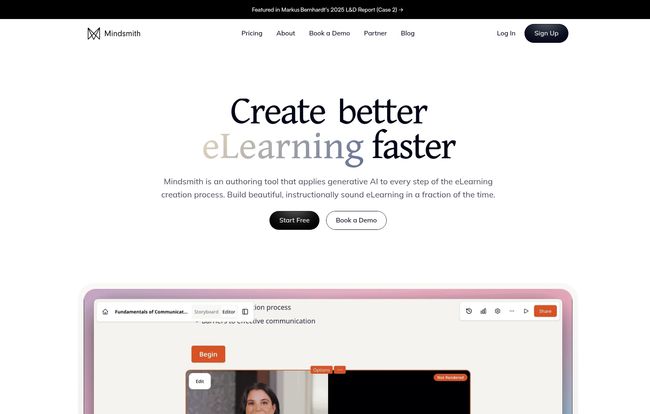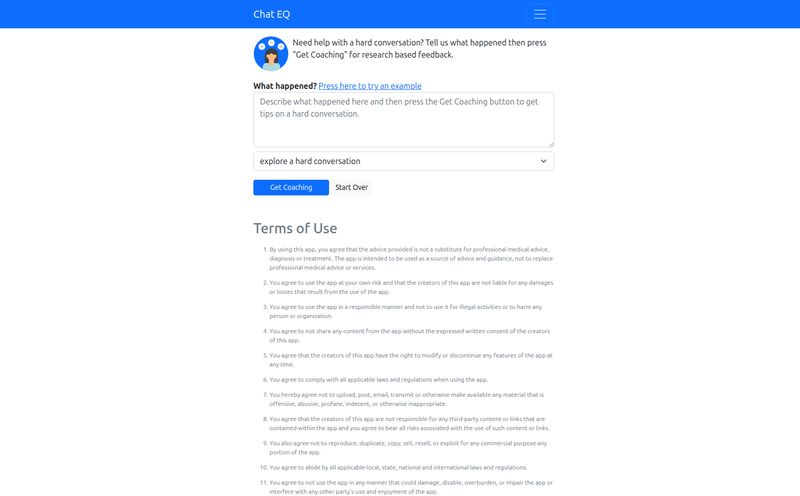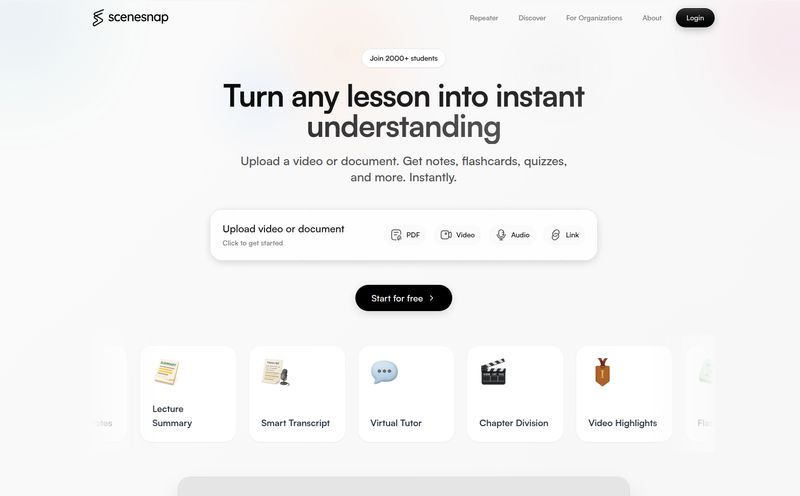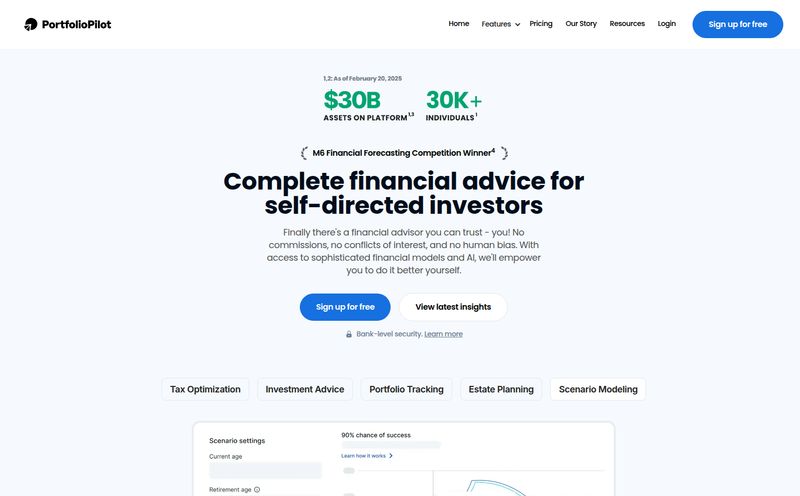I’ve been in the SEO and digital content game for a long time. Long enough to remember when 'interactive content' meant a flashy GIF and a 'contact us' form. In the corporate training world, things were even more dire. We’ve all been there, right? Staring down the barrel of a 150-slide PowerPoint that needs to be turned into a 'mandatory' training module by Friday. It's a soul-crushing, coffee-fueled grind.
So, whenever a new tool pops up promising to change everything, my inner cynic just rolls his eyes. 'Here we go again,' he mutters. But every so often, something comes along that actually makes me sit up and pay attention. Lately, that something has been Mindsmith. It's an AI-powered eLearning authoring tool, and frankly, it’s making some pretty bold claims about creating beautiful, effective micro-courses in a fraction of the time.
But does it deliver? Let's get into it.
So, What Exactly is Mindsmith?
Think of Mindsmith as a laboratory for creating and sharing bite-sized courses. It’s not trying to be a clunky, all-in-one LMS that costs a fortune and requires a dedicated IT team to manage. Instead, it’s a focused authoring tool that uses generative AI to help you build instructionally sound eLearning content. Fast. We’re talking about turning that dry, boring compliance document into an engaging micro-lesson before your second cup of coffee gets cold.
The whole idea is to blend the power of AI with the need for custom, on-brand educational materials. It’s designed for the real world of L&D, where time is short and attention spans are even shorter.
How Mindsmith Aims to Fix the Old, Broken Workflow
The traditional process is painful. You get a doc from a subject matter expert (SME), you hack it into slides, you write a script, you send it for review, you get a million conflicting edits back... you know the drill. It’s a waterfall of inefficiency. Mindsmith tries to turn that waterfall into a smooth-flowing river.
From Blank Page to Full Course with AI
One of the standout features is its generative AI assistant. You can literally start with a simple prompt, like "Create a micro-course on effective feedback for new managers," and it will generate a structured lesson with activities and assessments. It’s a fantastic starting point. It’s not going to replace the need for a human touch—let's be real, a good instructional designer is still gold—but it completely obliterates writer's block. It gets you from 0 to 60 in seconds, so you can spend your time refining and improving, not just building from scratch.
The Magic of Turning Documents into Courses
This is the part that really caught my eye. We all have them: those dense PDFs, Word documents, or even old slide decks gathering digital dust. Mindsmith lets you upload them and its AI will parse the content, identify the core concepts, and structure it into an interactive lesson. I tried it with an old blog post of mine on keyword research, and the result was surprisingly coherent. It pulled out the main points, suggested some knowledge-check questions, and laid it all out in a clean, scannable format. It's not perfect, but it's a hell of a first draft.

Visit Mindsmith
Finally, Real-Time Collaboration That Works
If you've ever had to manage feedback through tracked changes in Word or a flurry of emails, you'll appreciate this. Mindsmith is built for teams. Multiple people can be in a lesson at the same time, leaving comments and making edits. It’s like Google Docs for course creation. No more hunting for the right version file—you can finally say goodbye to `Onboarding_Course_v3_Final_JMs-edits_FINAL_2.pptx`. A small mercy, but a significant one.
Key Features That Actually Matter to L&D Pros
Beyond the AI flash, there are some solid, practical features baked in here that show they've actually talked to people who do this for a living.
- On-Brand Customization: You can set up your brand standards—logos, colors, fonts—so every course you create looks like it came from your organization, not some generic template. This is huge for maintaining a professional and consistent learner experience.
- Accessibility is Standard: The platform is WCAG 2.2 compliant. This isn't just a 'nice to have'; it's a necessity. Building accessible content can be a complex afterthought in many tools, but here it seems to be part of the foundation. Big points for that.
- Speak the Language: With support for over 30 languages, you can generate and edit content for a global workforce. The AI can even help with translation, which could be a massive time-saver for international companies.
- Plays Nice with Others: Your courses can be shared via a simple link or exported as SCORM or xAPI packages to be uploaded into your existing Learning Management System (LMS). That flexibility is critical for fitting into an established tech stack.
Let's Talk Money: The Mindsmith Pricing Tiers
Alright, the all-important question: what’s this going to cost? The pricing structure seems pretty straightforward and designed to scale with your needs. I’ve broken it down based on their pricing page.
| Plan | Price | Who It's For | Key Highlights |
|---|---|---|---|
| Free | $0 / month | Individuals or anyone wanting to test the waters. | Create 3 free lessons, add your own content, and get a feel for the AI. SCORM support is even included, which is generous. |
| Professional | $39 / user / month | Solo instructional designers, freelancers, or small team leads. | Unlimited lessons, document to course creation, advanced branding, and basic analytics. This seems to be the sweet spot for serious creators. |
| Business | $75 / user / month | Growing teams and established L&D departments. | Everything in Pro, plus team folders, version control, advanced roles, and priority support. Built for serious collaboration. |
| Enterprise | Custom Pricing | Large organizations with specific security and support needs. | Everything in Business, plus SSO/SAML, a dedicated success manager, and service level agreements (SLAs). The full-package deal. |
The free plan is genuinely useful for a trial run. The Professional tier feels very reasonably priced for the power it gives a single creator. For teams, the Business plan's collaborative features are likely a must-have.
The Good, The Not-So-Good, and The 'Coming Soon'
No tool is a silver bullet. After playing around and digging through the details, here's my honest take.
On the plus side, the speed is undeniable. The ability to generate a course framework with AI and collaborate in real-time is a massive workflow improvement. The focus on accessibility and multi-language support from the get-go is commendable. It just feels... modern.
However, there are a couple of things to keep in mind. First, the risk of AI hallucination is always there. Mindsmith mitigates this by grounding the AI in your source documents and style guides, but you still need a human to verify the output for accuracy and tone. Don't just ship what the AI gives you without a review.
Second, and this is a common thing with newer platforms, some features are still on the horizon. The analytics are there, but the promise of truly actionable insights to improve learning outcomes is tagged as 'coming soon'. That’s a feature I am genuinely excited for, but for now, the reporting seems more foundational than revolutionary.
So, Who is Mindsmith Really For?
I see a few groups getting a ton of value out of this:
- Corporate L&D Teams: Especially those drowning in requests for onboarding, compliance, and product training. This tool can drastically cut down development time.
- Instructional Designers: Whether freelance or in-house, it’s a powerful assistant for getting first drafts done quickly, letting you focus on the high-value work of instructional strategy and refinement.
- Small to Medium Businesses: For companies that don't have a dedicated L&D team, Mindsmith offers a way for HR managers or team leads to create quality training materials without a steep learning curve or massive budget.
Frequently Asked Questions about Mindsmith
1. Is the Free plan actually useful?
Yes, surprisingly so. For trying out the core functionality, creating a few lessons, and even exporting with SCORM, it's a perfect, no-risk starting point. You'll hit the limits pretty fast if you're a heavy user, though.
2. How good is the AI at creating content?
It's an excellent assistant, not a replacement for a human expert. It's great for structure, summarizing content, and generating ideas. But you absolutely need to review and refine its output for accuracy, nuance, and your company's specific tone of voice.
3. Can I use my company's branding?
Yes, starting with the Professional plan. You can customize logos, colors, and fonts to ensure all your micro-courses are consistent with your brand identity.
4. What does WCAG 2.2 compliant mean for me?
It means the courses you create with Mindsmith are designed to be accessible to people with disabilities, including those who use screen readers or have visual impairments. It’s a crucial aspect of creating inclusive learning experiences.
5. Can I import my existing PowerPoint presentations?
While it's optimized for documents like PDFs and Word files, you can typically save a PowerPoint as a PDF and upload it. The AI will then extract the text and structure a lesson from there.
Final Thoughts: Is Mindsmith a Revolution or Just Hype?
Here's the thing. I've seen a lot of tools come and go. Mindsmith feels different. It isn’t trying to be a magic wand that vaporizes the need for instructional designers. Instead, it feels like a powerful, intelligent assistant that handles the most tedious parts of the job.
It frees up L&D professionals to focus on what humans do best: strategy, empathy, and creating truly resonant learning moments. It's not about replacing people; it's about augmenting them. For any team that's felt the pain of the traditional course creation cycle, Mindsmith is, at the very least, worth a serious look. It might just be the workflow upgrade you've been waiting for.
Reference and Sources
- Mindsmith Official Website
- Mindsmith Pricing Page
- Web Content Accessibility Guidelines (WCAG) Overview



